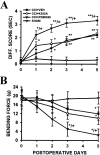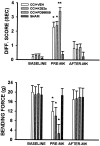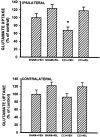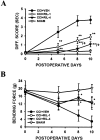Altered expression and uptake activity of spinal glutamate transporters after nerve injury contribute to the pathogenesis of neuropathic pain in rats
- PMID: 12684477
- PMCID: PMC6742068
- DOI: 10.1523/JNEUROSCI.23-07-02899.2003
Altered expression and uptake activity of spinal glutamate transporters after nerve injury contribute to the pathogenesis of neuropathic pain in rats
Abstract
The central glutamatergic system has been implicated in the pathogenesis of neuropathic pain, and a highly active central glutamate transporter (GT) system regulates the uptake of endogenous glutamate. Here we demonstrate that both the expression and uptake activity of spinal GTs changed after chronic constriction nerve injury (CCI) and contributed to neuropathic pain behaviors in rats. CCI induced an initial GT upregulation up to at least postoperative day 5 primarily within the ipsilateral spinal cord dorsal horn, which was followed by a GT downregulation when examined on postoperative days 7 and 14 by Western blot and immunohistochemistry. Intrathecal administration of the tyrosine kinase receptor inhibitor K252a and the mitogen-activated protein kinase inhibitor PD98059 for postoperative days 1-4 reduced and nearly abolished the initial GT upregulation in CCI rats, respectively. Prevention of the CCI-induced GT upregulation by PD98059 resulted in exacerbated thermal hyperalgesia and mechanical allodynia reversible by the noncompetitive NMDA receptor antagonist MK-801, indicating that the initial GT upregulation hampered the development of neuropathic pain behaviors. Moreover, CCI significantly reduced glutamate uptake activity of spinal GTs when examined on postoperative day 5, which was prevented by riluzole (a positive GT activity regulator) given intrathecally twice a day for postoperative days 1-4. Consistently, riluzole attenuated and gradually reversed neuropathic pain behaviors when the 4 d riluzole treatment was given for postoperative days 1-4 and 5-8, respectively. These results indicate that changes in the expression and glutamate uptake activity of spinal GTs may play a critical role in both the induction and maintenance of neuropathic pain after nerve injury via the regulation of regional glutamate homeostasis, a new mechanism relevant to the pathogenesis of neuropathic pain.
Figures








References
-
- Arriza JL, Kavanaugh MP, Fairman WA, Wu YN, Murdoch GH, North RA, Amara SG. Cloning and expression of a human neutral amino acid transporter with structural similarity to the glutamate transporter gene family. J Biol Chem. 1993;268:15329–15332. - PubMed
-
- Azbill RD, Mu X, Springer JE. Riluzole increases high-affinity glutamate uptake in rat spinal cord synaptosomes. Brain Res. 2000;871:175–180. - PubMed
-
- Bennett GJ, Xie YK. A peripheral mononeuropathy in rat that produces disorders of pain sensation like those seen in man. Pain. 1988;33:87–107. - PubMed
-
- Bennett GJ, Kajander KC, Sahara Y, Iadarola MJ, Sugimoto T. Neurochemical and anatomical changes in the dorsal horn of rats with an experimental painful peripheral neuropathy. In: Cervero F, Bennett GJ, Headley PM, editors. Proceedings of sensory information in the superficial dorsal horn of the spinal cord. Plenum; New York: 1989. pp. 463–471.
-
- Bigini P, Bastone A, Mennini T. Glutamate transporters in the spinal cord of the wobbler mouse. NeuroReport. 2001;12:1815–1820. - PubMed
Publication types
MeSH terms
Substances
Grants and funding
LinkOut - more resources
Full Text Sources
Other Literature Sources
Miscellaneous
